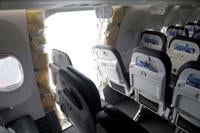Washington DC (CNN) 鈥� Federal Aviation Administration chief Mike Whitaker said his agency is partly responsible for the safety problems at Boeing, admitting that it had been 鈥渢oo hands off鈥� in its oversight of the troubled aircraft manufacturer.
In testimony Thursday before the Senate Commerce Committee, Whitaker said that his agency now had far more inspectors on the ground at Boeing factories and the factory of its primary supplier, Spirit AeroSystems. He said it will continue to push Boeing to improve its safety culture in the wake of the January 5 incident in which a flight, leaving a gaping hole in the side of the Boeing 737 Max.
But he also said that the FAA was not blameless in that incident.
鈥淟et me also acknowledge the FAA should have had much better visibility into what was happening at Boeing before January 5,鈥� he said in his opening remarks to the committee.
鈥淭he FAA鈥檚 approach was too hands off, too focused on paperwork audits and not focused enough on inspections. We have changed that approach over the last several months. And those changes are permanent,鈥� he said. 鈥淲e have now moved to a more active, comprehensive oversight model - the audit plus inspection approach.鈥�
Whitaker, who was heading the nation鈥檚 primary aviation regulator in October, said he will be visiting Boeing鈥檚 South Carolina factory himself tomorrow, and its plant that makes the 737 Max in Renton, Washington in September.
Whitaker said that the FAA previously had 24 inspectors at Boeing and Spirit and that the number was in the low 30s now. Its target is 55 inspectors, although he did not give a date for when that would be in place. And he said that number could change over time.
鈥淲e can no longer afford to remain reactive,鈥� he said.
A preliminary report by the National Transportation Safety Board has found that bolts necessary to keep the door plug on the Alaska Air plane in place were at the time it left the Boeing factory in Washington roughly two months before the flight. Under questions at Thursday鈥檚 hearing, Whitaker said the FAA did not have any inspectors in the factories at that time when the piece was put in.
Instead the FAA staff was focused on paperwork audits instead of actual inspections.
鈥淲e clearly did not have enough folks to see what was going on in that factory,鈥� he said.
Safety experience鈥� in the dairy industry
But finding the inspectors could be a problem. Sen. Maria Cantwell, the Washington Democrat who is chair of the committee, questioned the backgrounds of some of the safety inspectors.
鈥淚鈥檓 definitely hearing 鈥榃e don鈥檛 have enough aviation inspectors.鈥� And 鈥榃e don鈥檛 even have enough qualified instructors at schools,鈥欌€� she said. 鈥淥ne story I heard was that they said, 鈥榊es, I have safety experience. But it鈥檚 in the dairy industry.鈥� We need an aviation inspector on the floor who has aviation experience, not just safety experience.鈥�
Whitaker responded that while the agency is having to provide some training for new hires, it is finding the experienced inspectors it needs for Boeing.
鈥淲ith respect to Boeing, we鈥檙e putting our most experienced and best people on this,鈥� he said. 鈥淚t鈥檚 certainly the most important issue we鈥檙e dealing with right now.鈥�
But for years the FAA has relied on employees of Boeing and other manufacturers to inspect their own companies, then report to the FAA, under what is known as 鈥�.鈥� That structure is still in place, even with more FAA employees now on the floor at Boeing factories.
That reliance on self-inspection and self-certification first started getting attention in 2019 after two fatal crashes of the 737 Max that killed 346 people and led to a 20-month grounding of the plane. The fact that much of the certification of the Max, a relatively new aircraft, was done by Boeing employees, not FAA staff, raised questions in Congress and an outcry among families of some of the crash victims.
In January, after the Alaska Air flight, Whitaker joined those who suggested the process needed to be changed.
鈥淚t is time to re-examine the delegation of authority and assess any associated safety risks,鈥� said Whitaker a week after the incident. 鈥淭he grounding of the 737-9 and the multiple production-related issues identified in recent years require us to look at every option to reduce risk.鈥�
In February the to come up with a plan to improve safety. And in late May when the plan was submitted, the FAA announced it was leaving a until safety improves.
鈥淭here must be a fundamental shift in the company鈥檚 safety culture in order to holistically address its quality and safety challenges,鈥� Whitaker said on Thursday. 鈥淭his is about systemic change, and there鈥檚 a lot of work to be done.鈥�
But he said there has been a shift in tone in discussions between the FAA and Boeing executives since the January incident.
鈥淢y focus has been on making it clear this is a very long-term journey. You don鈥檛 change the culture of an organization. We鈥檝e seen an increasing recognition that this is a long journey ahead.鈥�
Boeing also said it has made significant changes since January.
鈥淲e listened to our employees, engaged transparently with our regulator, welcomed the findings and recommendations from the FAA 鈥�. and invited scrutiny from customers and independent experts,鈥� it said in a statement when asked for a comment on Thursday鈥檚 hearing. 鈥淲e will work under the FAA鈥檚 oversight and uphold our responsibility to the flying public to continue delivering safe, high-quality airplanes.鈥�
This story has been updated with additional reporting and context.
The-CNN-Wire
鈩� & 漏 2024 Cable News Network, Inc., a Warner Bros. Discovery Company. All rights reserved.














